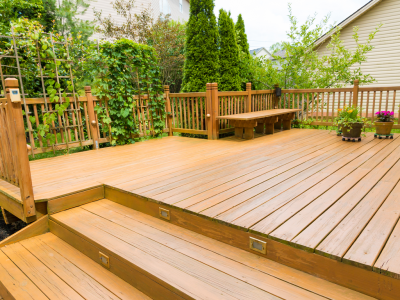
Give Your Wood Deck a Fresh Lease on a Long Life
Wood decks can provide a delightful option for outdoor relaxing, cooking, and entertaining. But decks also need a little love to last long and look their best.
Is it time to tackle this job? Typically, wood decks need to be stained or resealed every year or two depending on your climate, your deck’s exposure to the sun, and its age. Late spring is often an ideal time to roll up your sleeves before temperatures climb!
Routine deck maintenance involves several steps.
1. Clean
Begin with a blank canvas. Move everything off the deck before you start cleaning. If any vines, tree branches, or seedlings are growing into (or through) your deck, remove them too.
Thoroughly sweep the deck and remove any debris trapped between the boards with a stiff plastic brush or a putty knife.
Then, use your garden hose or a bucket of soapy water and a long-handled brush to clean the surface and space between the boards. Rinse thoroughly.
2. Check for problems
Once your deck’s surface is clean, evaluate it for any other areas of concern.
Tackle any stains
If your initial wash left stains behind, consider one of these more extensive cleaning methods.
Pressure washing – Although many homeowners pressure wash their deck, this method can gouge wood and damage the finish, raising the grain and making the surface appear “fuzzy.” If you decide to pressure wash, exercise caution. Use a wide nozzle, a low-pressure setting, and keep the wand at least a foot from the surface to avoid damage.
Bleach – Bleach can remove mold stains. However, avoid using chlorine bleach since it damages wood and prevents stains and sealant products from adhering correctly. (It can also damage plants, the siding on your home, paint, and walkways.)
Instead, use a deck cleaning product with oxygen bleach and plan to add some elbow grease to lift the mold.
No matter what type of cleaner you use, be sure to test it on a small area before using it all over your deck. And rinse thoroughly to remove any remaining residue.
Inspect for damage
Look for any rotted or damaged areas that need to be patched. Any loose or twisted boards or railings should be secured or replaced. If nail heads are missing or raised, replace them with new nails or wood screws.
Check under the deck, too, to ensure there are no structural issues.
3. Sand
If your natural wood deck has grayed, a light sanding will help bring back the natural color of the wood. Sanding can also restore the appearance of a deck with any raised woodgrain or light surface damage.
Even if your deck doesn’t appear to need sanding, a light once-over will help sealant or stain adhere better.
However, before you begin sanding (or proceed to staining or sealing), wait for your deck to dry completely. Depending on how deeply you cleaned and what products you used, two or three days should be sufficient. Sanding wet wood is never a best practice, and you don’t want to seal moisture in.
4. Stain or reseal
First, select your method to protect your deck. If you like the look of natural wood, a sealant is your best bet. Staining will add color, although most stain products also include a sealant. Additionally, a stain can help protect your deck wood from UV damage.
Next, choose your product type.
Oil-based stains and sealants tend to last a little longer than water-based products but require using chemicals (paint thinner) to clean your brushes and tools. NOTE: If you are applying a stain or sealant to a deck that has been previously stained or sealed, it’s essential to know what was used before. Oil-based products will only adhere to oil-based products.
Water-based stains and sealants may be less durable than their oil-based counterparts, but cleanup is a breeze, and no chemicals are required. Another plus is that water-based products will adhere to water- OR oil-based products. If you don’t know what’s already on your deck, a water-based stain or sealant is a safe bet.
Rope off your deck until it dries thoroughly, so family, friends, or pets don’t accidentally walk on it. Then, move your furniture, grill, and outdoor living accessories back in place and enjoy your outdoor living space for the rest of the year!
